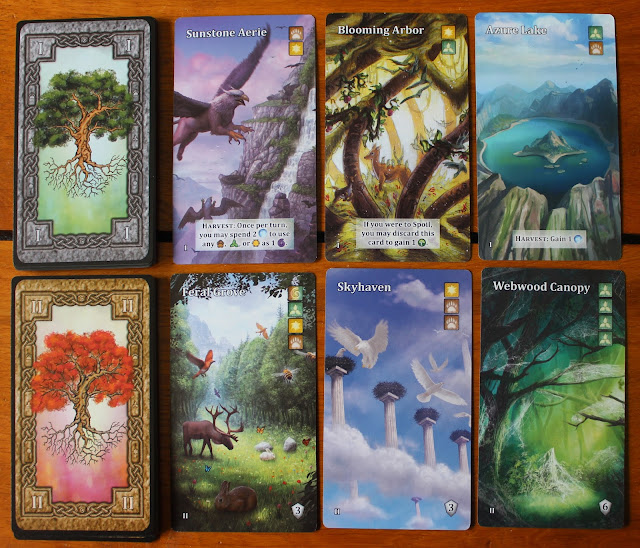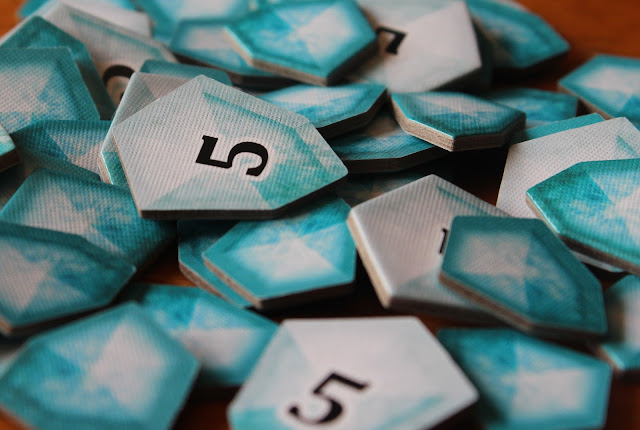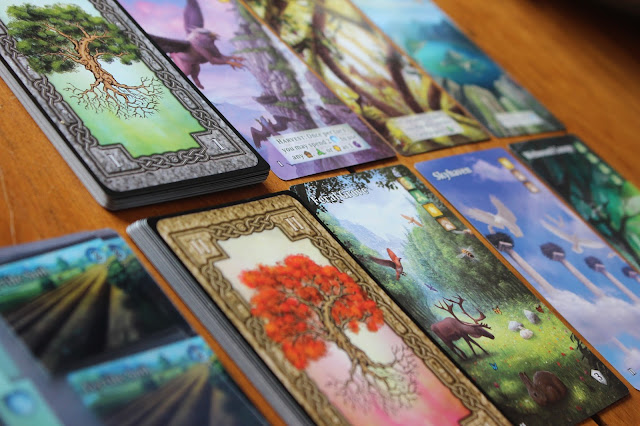As anyone who's met me in any kind of geek capacity will know, I'm one of life's support characters. Somewhere around 95% of my pen-and-paper RPG characters take their classes from the following priority list: druids > other healers > scientists > wait, there are other characters? Yes, my default game setting is to immediately pretend I have sticks in my hair and possibly a talking badger. So it was with no small amount of happiness that I broke open my shiny new copy of Mystic Vale, a deck-building game with a lovely theme and definitely the coolest, most novel cards in my collection to date.
The Beastbrothers, Lifewardens, Dawnseekers and Waveguards are druidic clans tasked with safeguarding and restoring the cursed-but-mystical Valley of Life. Each player takes on the role of one of these clans and uses their magical druidey powers to bring the Mystic Vale back to life, one card upgrade at a time. Clever, see-through plastic upgrades!
Although not the first game to use the 'clear plastic cards' idea, Mystic Vale did mark the debut of AEG's Card Crafting System, due to be continued with Edge of Darkness later this year. The idea of the Card Crafting System is that rather than gradually adding cards to improve your deck as you would in a normal deck-builder, you instead start the game with a deck of sleeved starter cards into which you slide clear plastic upgrades that add new powers and symbols. Now not only are you worrying about how your cards work together as a deck, but also the interplay of individual sections of the cards. Sounds complicated? I promise, it's not so bad!
As with most deck-building games, your original deck is made up of almost-but-not-quite complete uselessness, although this game is unique in my experience for including some cards that start out absolutely blank...
You'll spend the rest of the game trying to make your 20-card base deck look a little more like the picture below, with the thematic idea being that each card is a piece of the valley that you're working to restore to life:
This is such a fun idea, although the fact that you aren't allowed to cover any existing sections of a card with upgrades means you'll be forever stuck with nasty Cursed Land sections in your beautiful new valley... Sad times!
At its heart, Mystic Vale is a race to build the best cards into the fastest engine to score the most victory points. This engine runs on a number of symbols, including those for growth (happy green tree), decay (mean red tree), mana (blue circle), victory points (blue gem), spirit (animal, forest, sky and the swirly purple wild spirit) and the guardian (helm).
During setup of the game, each player will lay out their initial field of cards. This is the most fiddly bit to explain but breaks down nicely into steps:
- Flip the first card of your deck and lay it back on top of the deck face up. This card is now known as your on-deck card.
- Play the on-deck card onto the table to start off your field
- Turn over a new on-deck card
- Play the new on-deck card into your field
- Turn over a new on-deck card
- Continue in this manner until you have two decay symbols showing in your field and one on the on-deck card
This is the starting point for every turn, which then goes through the following phases:
Planting Phase
This is the push-your-luck part! If you're happy with the field set up above, you can choose to pass and move on to the Harvest phase. However, if you're feeling brave/lucky/good at probability, you can choose to push and play your next on-deck card into your field. This means you have to turn over a new on-deck card. If the new card shows a decay symbol (meaning you have four or more decay symbols revealed) sadly you spoil, effectively ending your turn. This phase is basically like playing Blackjack but with mean red trees...There is a little consolation prize for spoiling: you get to turn over your mana token, which gives you one more mana to spend on a future turn. Not great, I know, but better than nothing, eh? It's easy to become overly familiar with this token, as it can be hard to resist the little voice that says 'if only I could just get one more mana to spend...What could possibly go wrong?' I'm fairly sure it's the same self-destructive voice that tells me it's fine to have another biscuit or that it's definitely okay to back *another* new Kickstarter project. Spoiling on every turn is not going to win you the game, though, so it's often wise to settle for what you've been dealt!
Harvest Phase
If you pass on the Planting Phase without spoiling, you get to resolve any 'harvest' abilities on the cards in your field and count up what's available to spend on shiny new upgrades (remember not to count the symbols on your on-deck card!)Mana symbols can be spent on advancement cards. There are nine advancements available at any one time as well as a pool of basic Fertile Soil cards. These can be for the top, middle or bottom of a card, and you can only buy upgrades that will fit onto one of the cards in your field without covering up something that's already on the card.
Spirit symbols can be spent on vale cards, which offer various abilities to supplement the cards in your deck:
You can also harvest any victory point tokens indicated by blue gem symbols on the left side of your cards. When the little heap of victory point tokens runs out, the game ends after the current round is completed.
If you see any grey gem symbols on your advancement or vale cards, they count as extra victory points at the end of the game.
There are also guardian symbols, which can do different things depending on the context of the card, for instance 'gain one victory point token for each guardian symbol on this card'. This throws in an extra thing for you to think about collecting in your deck, although usually provides a focus for a particular card.
Discard Phase
During the discard phase you need to sleeve any advancement cards you purchased and replenish any advancement or vale cards that you bought from the supply.This is where the next player can start their turn, while you move on to the prep phase.
Prep Phase
The final part of a turn is to set up the field for your next turn. Just like you did at the beginning of the game, play your on-deck cards into the field until you are showing three (or more) decay symbols. You're then ready to go as soon as it's your turn again (which it usually is, by the time you've done this!)As mentioned above, the game ends when all the victory point tokens are claimed and when everyone has had an equal number of turns. Everyone counts up their points, either from tokens or cards, and the most points wins.
I'm happy to say that I really enjoyed Mystic Vale. I love the new dimension added to the standard deck-builder puzzle by making it important to have combinations on individual cards as well as making your deck fit together. The game plays really quickly, with tiny amounts of downtime between turns. This is partly because you're busy setting up your turn while everyone else takes theirs, but is also helped by the finite number of choices available. There will only ever be a small number of things you can afford to buy on each turn, and often some of them won't fit in to the empty spaces on your cards anyway! That doesn't make the choices less interesting, though, and whatever you choose always feels positive because even if you haven't bought the optimal card, it's always going to be better than the blank card you started with.
The see-through cards shtick is not new, by any means - games like Gloom and Redakai use the same idea to good effect - but this is the implementation I've enjoyed the most. The sleeved base cards make the whole arrangement easy to manage and fun to use. There's a huge amount of satisfaction to be gained from filling cards with lots of shiny upgrades, both visually and when they power your points-grabbing engine.
The setup time for the game is minimal (after the first game, which can take a while if you're planning to peel off all the film coverings on the plastic cards) and tear-down is not as cumbersome as I thought it might be, if people help to unsleeve and sort their own cards when the game ends. The rules are clear and all the quick reference material provided is really helpful, both on the back of the rulebook and on individual player reference cards.
I do have a few niggles with the game, though. Trying to 'shuffle' the plastic cards has made me want to throw the deck straight out of the window. Static is not your friend in Mystic Vale, and with or without their original film covering the advancement cards can tend to glue themselves together. A few plays renders the cards a little grubbier and easier to separate, but the first few games may leave you slightly rage-filled when setting up the game. It's lucky they're pretty!
Mystic Vale can also be a very solitary experience, as there's not a lot of player interaction. It's fun to watch someone if they choose to push their luck in the planting phase, although in a two-player game you can end up missing this whilst buried in your own prep phase.
The theme is fairly thin, with everything translating quickly back into coins and points, although I like the idea that the cards are 'blooming' as you develop them and the artwork is really beautiful throughout, which helps a lot.
All-in-all this is a really solid, fun game with plenty of options and replayability. It might not be for you if you hate games with an element of luck thrown in (or if you are easily enraged by static), but for fans of deck-building games in general this will be a fun twist on a comfortably familiar experience. If you do start to feel like you've exhausted all available combos there are already two expansions on offer to help fill up the pre-requisite empty box-space: Mystic Vale: Vale of Magic and Mystic Vale: Vale of the Wild.
If you'd like to read more about the Card Crafting System, I came across a really interesting article by the game's designer, John D Clair, on the development process for (amongst other things) Mystic Vale on the AEG website.
Mystic Vale
Designer: John D ClairPublisher: Alderac Entertainment Group (AEG)
Players: 2-4
Age: 14+
Cost: RRP £41.99 [Find your friendly local brick-and-mortar retailer in Europe]
Thanks to Esdevium for sending me a copy to take a look at. If you enjoyed this post perhaps you could take a look at my Facebook page and leave a like or come and say hello on my Twitter or Instagram feeds!










